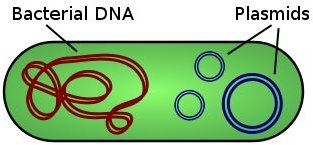Cloning Steps for Genes: How Geneticists Use the Basic Steps in Gene Cloning in Recombinant DNA Technology
Identification and Isolation of the Gene
The first of the basic steps in gene cloning in recombinant DNA technology involves the identification and isolation of the desired DNA sequence. Essentially, the process begins the same way genetic engineers perform gene splicing?. Scientists first identify the particular gene in which they wish to splice onto a vector, a material used to transmit the gene into the bacteria. The majority of genes and their functions are listed in a complimentary DNA or genomic DNA library. Once the identification process is completed, he or she must commit to isolating the gene itself from an organism.
Isolation, the process of removing the desired gene from the rest of the sequence, is accomplished using restriction enzymes. Restriction enzymes are proteins that act as the catalyst for a chemical reaction and cleave the phosphodiester bond, the covalent bond of the deoxyribose in DNA. Basically, these restrictive enzymes are introduced to the restriction site, the location which the geneticist wants to remove the gene. It breaks the strand and isolates the desired gene, ready for introduction to the vector.
Insertion of the Gene into the Vector
Scientists remove a portion of the bacteria known as a plasmid. This is a molecule capable of replicating outside the chromosomal DNA, making it an ideal candidate for gene cloning. Plasmids are double-stranded and circular. Scientists use restriction enzymes to remove the corresponding gene along the plasmid and then attach the new gene using a fusion enzyme. To prevent additional cleaving on the genes, a hydrophobic alkyl molecule is introduced to repel the remaining restriction enzymes. This process is called methylation. The host vector is now ready to be introduced to the microorganism.
Introduction of Vector to Host Cell
Using two different methods, the plasmid with the new gene is now introduced to a host cell such as the bacteria Escherichia coli, commonly referred to as E. coli. The first method used places the plasmid with the organism and introduces it to calcium chloride. With a change in temperature, this stimulates the molecule to enter the organism. Another method involves the process of electroporation, stimulating the cell with electricity until the plasmid enters. This creates a fully-integrated cell with modified genetics.
Cloning the New Gene
Since plasmids replicate without the use of a chromosome, it creates copies of itself at a very fast rate within the bacteria. Furthermore, a microorganism such as E. coli will reproduce faster than nearly any other in the world, making it a prime candidate for recombinant DNA research. Scientists simply place the subject with the vector in a culture and allow it to replicate. Then, through a process known as lysis, they break down the cells using the same restriction enzymes as before. This allows them to harvest the cloned gene in an efficient manner. By following these basic steps in gene cloning in recombinant DNA technology, geneticists can create multiple genetic codes with new protein production resulting in cells with new functions.
Reference
“Recombinant DNA Technology and Gene Cloning” Microbiology Procedure: https://www.microbiologyprocedure.com/biotechnology-in-agriculture/recombinant-dna-technology-and-gene-cloning.html
Recombinant DNA and Gene Cloning: https://users.rcn.com/jkimball.ma.ultranet/BiologyPages/R/RecombinantDNA.html
Image Source
Plasmid. (Supplied by Spaully at Wikimedia Commons; Creative Commons 2.5; https://upload.wikimedia.org/wikipedia/commons/c/cf/Plasmid_%28english%29.svg)
This post is part of the series: The Genetics of Recombinant DNA
Recombinant DNA is the process of merging genes from one organism with the genes of another organism. The most common method to complete the process involves using restriction enzymes to isolate a gene and then place it on a vector plasmid. It is then inserted into a host cell such as bacteria.
